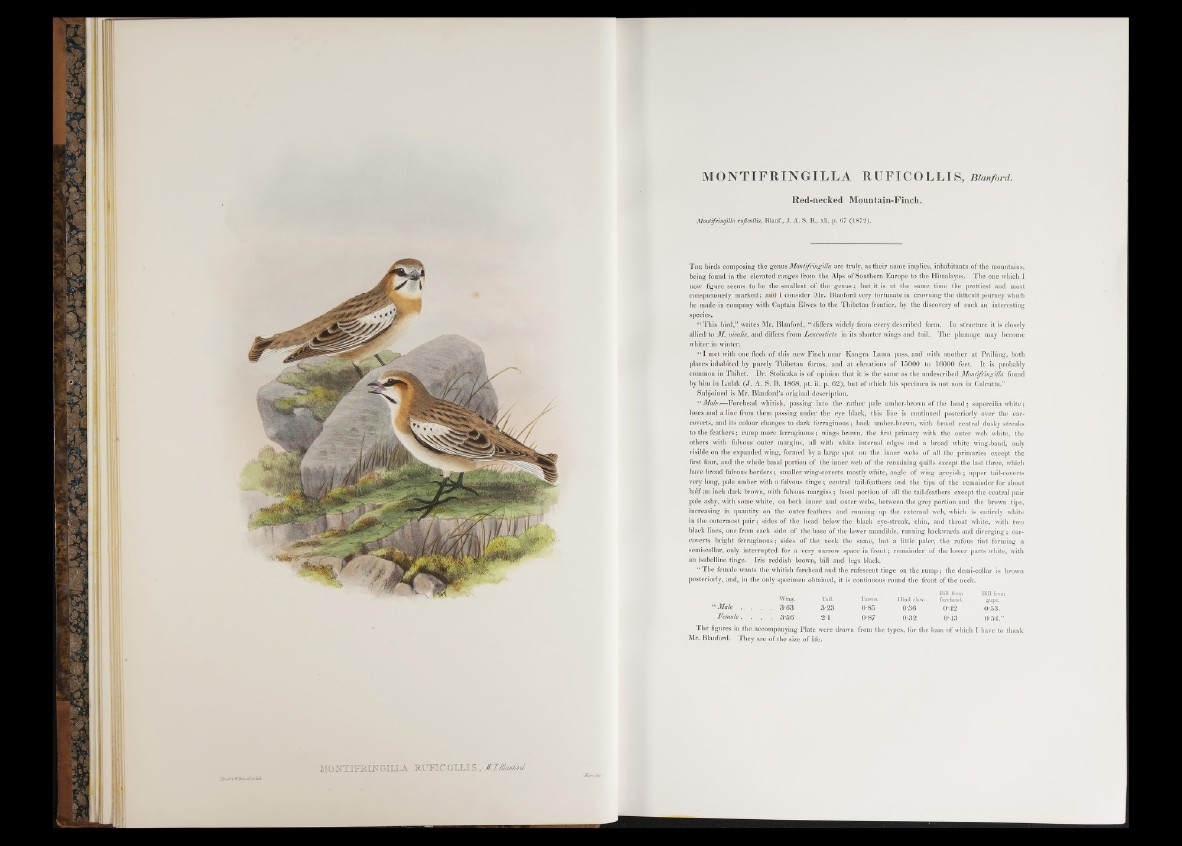
MONTIFBINGIL1LA R U F IC 0 1L ISW .IBhM ’■Ktifcr.Jmp
MONTIFRINGILLA RUFICOLLIS, Stanford.
Red-necked Mountain-Finch.
Montifringilla ruficollis, Blanf., J. A. S. B., xli. p'. 67 (1872).
T h e birds composing the genus Montifringilla are truly, as their name implies, inhabitants of the mountains,
being found in the elevated ranges from the Alps of Southern Europe to the Himalayas. The one which I
now figure seems to be the smallest o f the genus; but it is at the same time the prettiest and most
conspicuously marked; an'd I consider Mr. Blanford very fortunate in crowning the difficult journey which
he made in company with Captain Elwes to the Thibetan frontier, by the discovery of such an interesting
species.
“ This bird,” writes Mr. Blanford, “ differs widely from every described form. In structure it is closely
allied to M. nivalis, and differs from Leucosticte in its shorter wings and tail. The plumage may become
whiter in winter.
“ I met with one flock o f this new Finch near Kangra Lama pass, and with another at Pralung, both
places inhabited by purely Thibetan forms, and at elevations of 15000 to 16000 feet. It is probably
common in Thibet. Dr. Stoliczka is of opinion that it is the same as the undescribed Montifringilla found
by him in Ladak ( J . A. S. B. 1868, pt. ii. p. 62), but of which his specimen is not now in Calcutta.”
Subjoined is Mr. Blanford’s original description.
“ Male.—Forehead whitish, passing into the rather pale umber-brown of the head; supercilia white;
lores and a line from them passing under the eye black, this line is continued posteriorly over the ear-
coverts, and its colour changes to dark ferruginous; back umber-brown, with broad central dusky streaks
tb the feathers; rump more ferruginous; wings brown, the first primary with the outer web white, the
others with fulvous outer margins, all with white internal edges and a broad white wing-band, only
visible on the expanded wing, formed by a large spot on the inner webs of all the primaries except the
first four, and the whole basal portion of the inner web of the remaining quills except the last three, which
have broad fulvous borders; smaller wing-coverts mostly white, angle of wing greyish ; upper tail-coverts
very long, pale umber with a fulvous tin g e ; central tail-feathers and the tips of the remainder for about
half an inch dark brown, with fulvous margins; basal portion of all the tail-feathers except the central pair
pale ashy, with some white, on both inner and outer webs, between the grey portion and the brown tips,
increasing in quantity on the outer feathers and running up the external web, which is entirely white
in the outermost p a ir ; sides of the head below the black eye-streak, chin, and throat white, with two
black lines, one from each side of the base of the lower mandible, running backwards and diverging; ear-
coverts bright ferruginous; sides of the neck the same, but a little paler, the rufous tint forming a
semi-collar, only interrupted for a very narrow space in fro n t; remainder of the lower parts white, with
an isabelline tinge. Iris reddish brown, bill and legs black.
“ The female wants the whitish forehead and the rufescent tinge on the rum p ; the demi-collar is brown
posteriorly, and, in the only specimen obtained, it is continuous round the front of the neck.
Bill from Bill from
Wing. Tail. Tarsus. Hind claw. forehead. gape.
“ Male . . . . 3-63 3-23 0 85 0 3 6 0-42 0 5 3 .
Female. . , . 3-56 2 1 0 8 7 0 3 2 0 4 3 0 54.”
The figures in the accompanying Plate were drawn from the types, for the loan of which I have to thank
Mr. Blanford. They are o f the size of life.